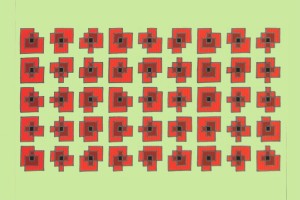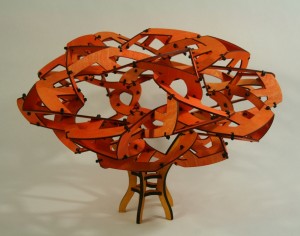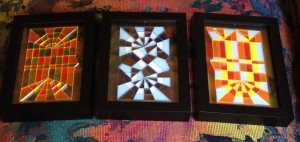People News for March
Kattchee, Hart, Orndorff Art Top Mathematical Exhibition
The 2016 Mathematical Art Exhibition awards were made at the Joint Mathematics Meetings “for aesthetically pleasing works that combine mathematics and art.” The three chosen works were selected from the exhibition of juried works in various media by 79 mathematicians and artists from around the world.
“45 Poppies,” by Karl Kattchee, was awarded best photograph, painting, or print. “By using mathematics as part of the creative process, I can infuse my art with mathematics without necessarily representing any particular mathematical thing,” said Kattchee. “On the other hand, the mathematical content may be right at the surface. Mathematical art can be conceptual, too. I use pencil, pen, pastel, paper, cardboard, scanner, camera, computer, printer, and metals to achieve my desired effects.”
Kattchee, associate professor of mathematics at the University of Wisconsin-La Crosse, described his work as follows:
The 2015 work is an 18 x 31 cm digital print.
“Sword Dancing,” by George Hart, was awarded best textile, sculpture, or other medium. “As a sculptor of constructive geometric forms, my work deals with patterns and relationships derived from classical ideals of balance and symmetry,” said Hart. “Mathematical yet organic, these abstract forms invite the viewer to partake of the geometric aesthetic.”
Hart, a research professor at Stony Brook University, described his work as follows:
The work is made of wood (dyed) and cable ties and measures 32 x 45 x 45 cm.
“OSU Triptych No. 2,” by Robert Orndorff, received honorable mention. “My paper folding art is math plus paper,” said Orndorff. “Folded paper is simply tangible math. These particular figures can be folded from most types of paper. No tools are needed.”
Orndorff described his work as follows:
The paper and acrylic triptych, made in 2015, is 20 x 46 cm.
The Mathematical Art Exhibition Award was established in 2008 through an endowment provided to the American Mathematical Society by an anonymous donor who wishes to acknowledge those whose works demonstrate the beauty and elegance of mathematics expressed in a visual art form. The awards are $400 for best photograph, painting, or print; $400 for best textile, sculpture, or other medium; and $200 for honorable mention.
The Mathematical Art Exhibition of juried works in various media is held at the annual Joint Mathematics Meetings of the American Mathematical Society and Mathematical Association of America. Works in the 2016 exhibition will be in an album on Mathematical Imagery.
Sujit Ghosh
Statistical and Applied Mathematical Sciences Institute deputy director and professor of statistics at North Carolina State University, Sujit Ghosh, recently received an honorary doctoral degree in statistics from Thammasat University in Thailand.
This is one of the highest forms of recognition a university can offer, and Thammasat University (TU) usually reserves the honor for people from Thailand. Ghosh has been visiting the department of mathematics and statistics at TU since the summer of 2005. “I have offered several short courses (e.g., Bayesian methods, Monte Carlo statistics, spatial statistics, etc.) which have now been incorporated into their doctoral curriculum,” said Ghosh.
In addition to graduate students, the courses were attended by TU faculty, who are now trained to offer such courses on their own.
Ghosh also co-supervised at least four doctoral students from TU who initially attended his courses and then worked with him to complete their doctoral dissertations. Three visited him at North Carolina State University during the last six months of their doctoral programs to complete their theses. All are currently serving as lecturers at renowned universities in Thailand.
“I am truly honored to receive this recognition from Thammasat University. I hope to continue our wonderful relationship,” said Ghosh.
Shahjahan Khan
The Bangladesh Academy of Sciences (BAS) invited one of its expatriate fellows—Shahjahan Khan of the University of Southern Queensland, Australia—to present a keynote address at a seminar on meta-analysis with applications in medical studies. The seminar was held at the academy auditorium located at the National Museum of Science and Technology building in Agargaon, Dhaka, December 31, 2015.
The chair of the seminar and former secretary of the academy, Naiyyum Choudhury, briefly talked about BAS and then introduced Khan. He also explained that BAS fellowship is not awarded through application, but rather by invitation subject to election by the majority of the fellows in its general meeting.
The seminar attracted a large number of participants, especially researchers in the public health area. Khan’s presentation focused on how evidence-based medicine has changed teaching and research in the health sciences. Meta-analysis has provided a way of synthesizing outcomes of independent studies with higher statistical precision and validity. The key role of statistics in estimating common effect size using meta-analytic methods within the evidence-based decision-making process was highlighted in the seminar.
Khan’s presentation created significant interest among the participants in using meta-analysis in the public health sector. This was reflected by a number of positive comments and interesting questions from the audience.




















